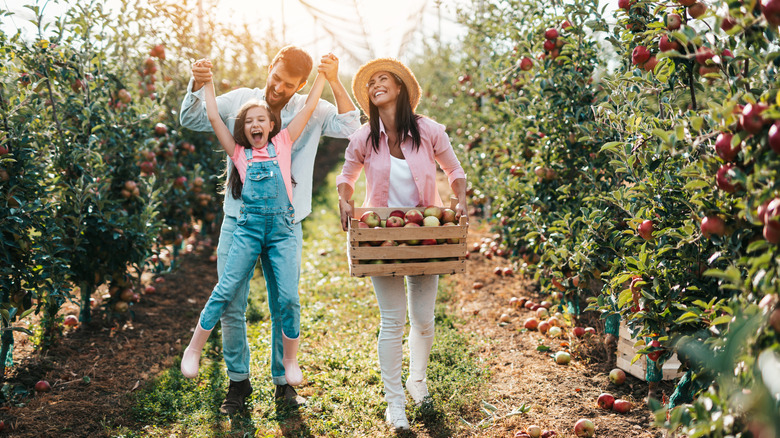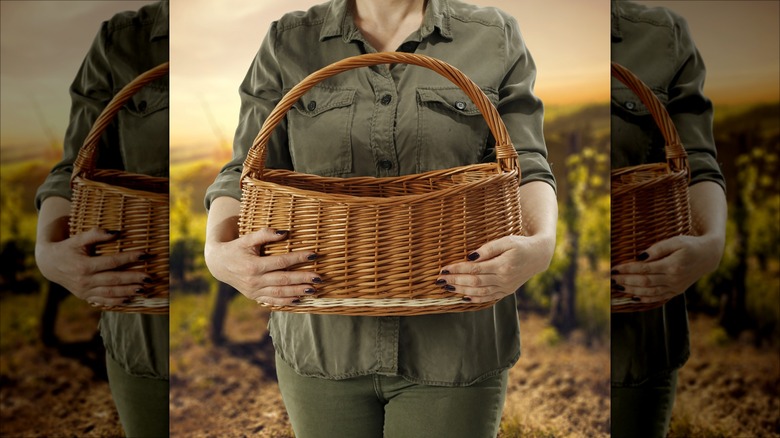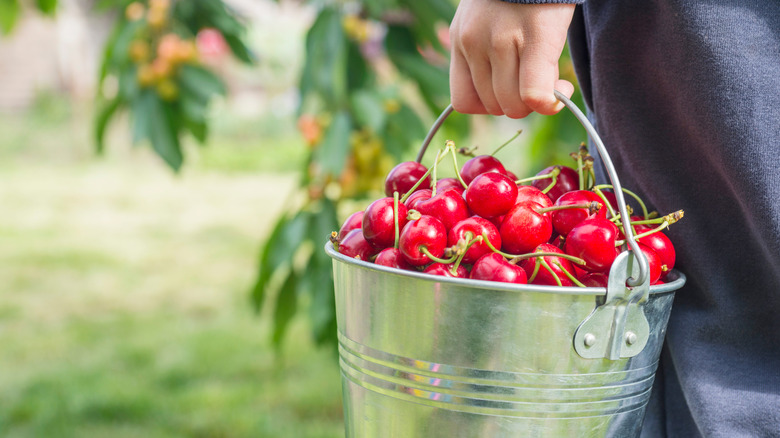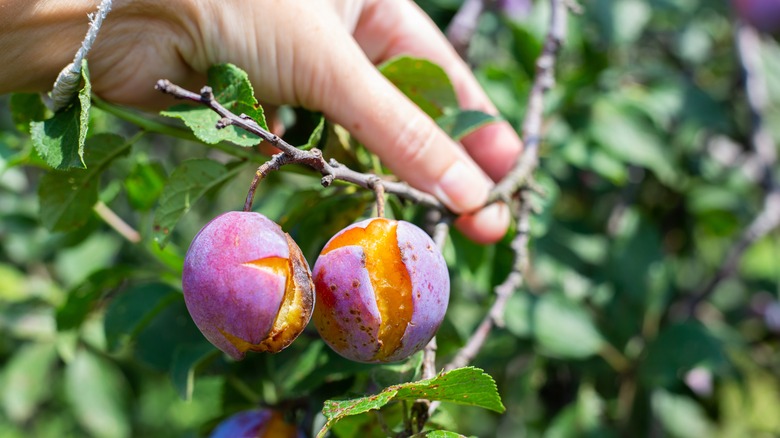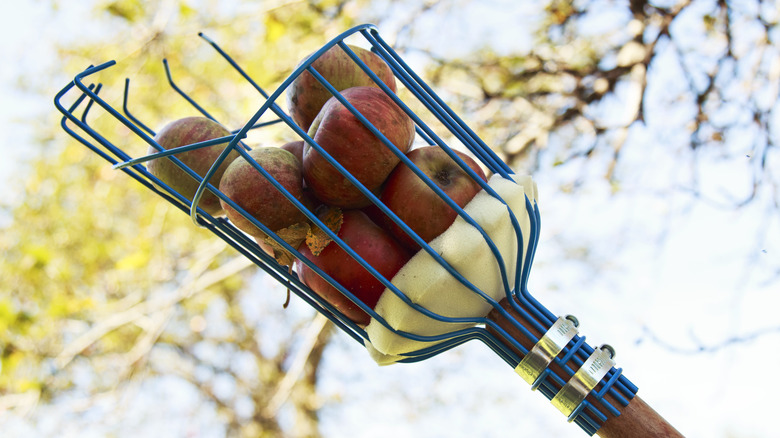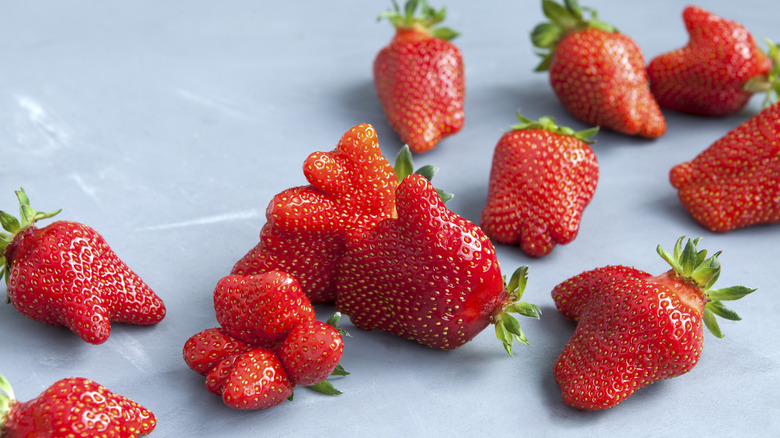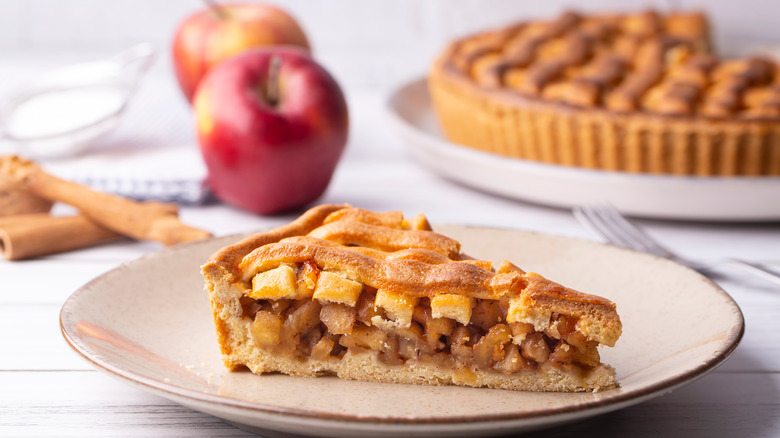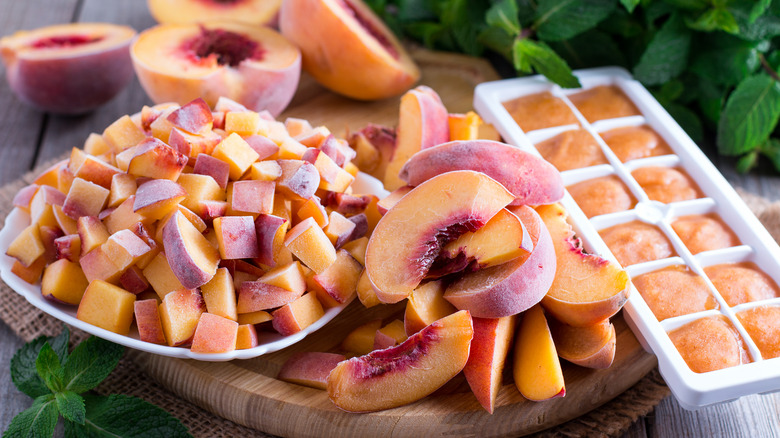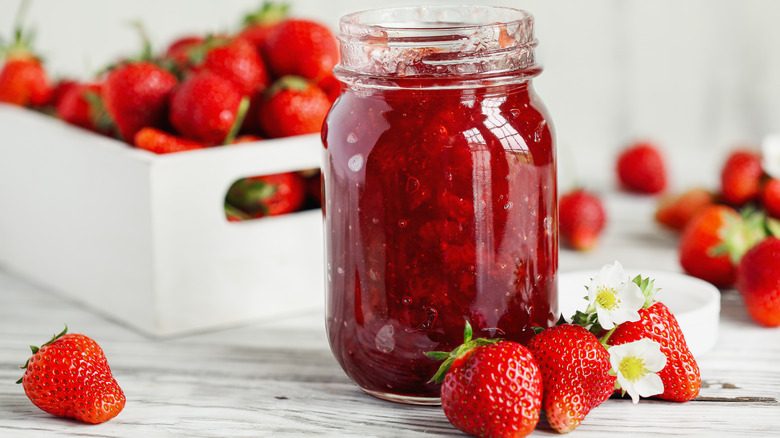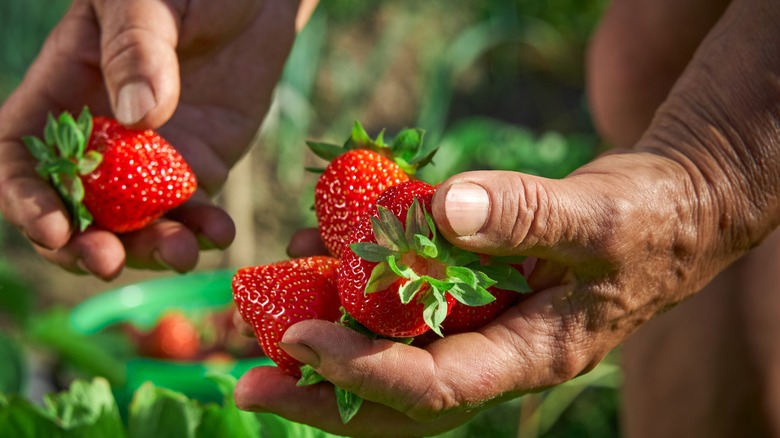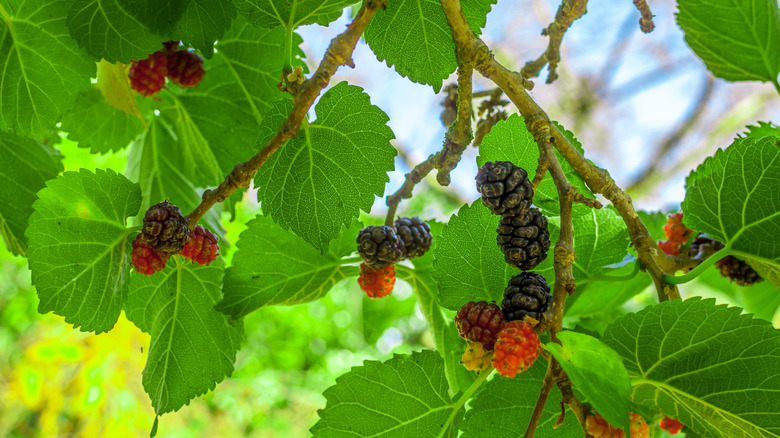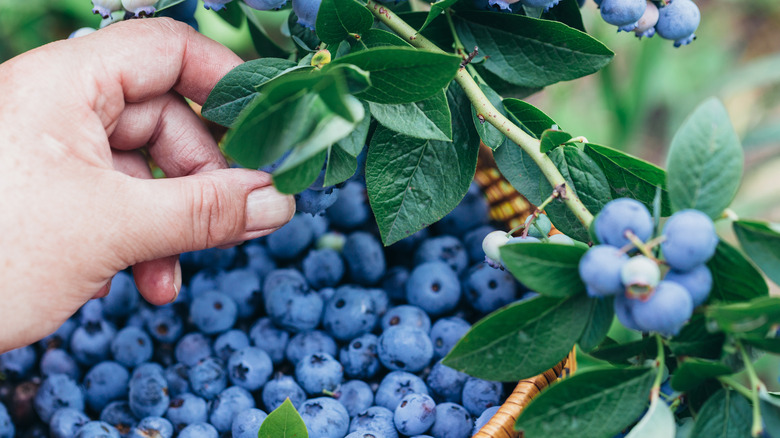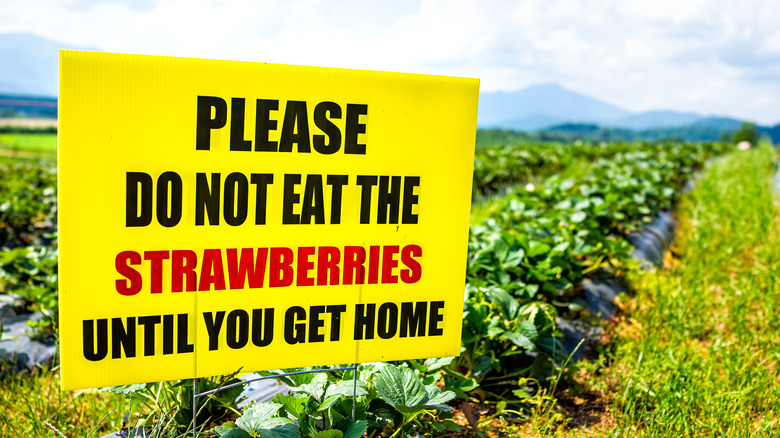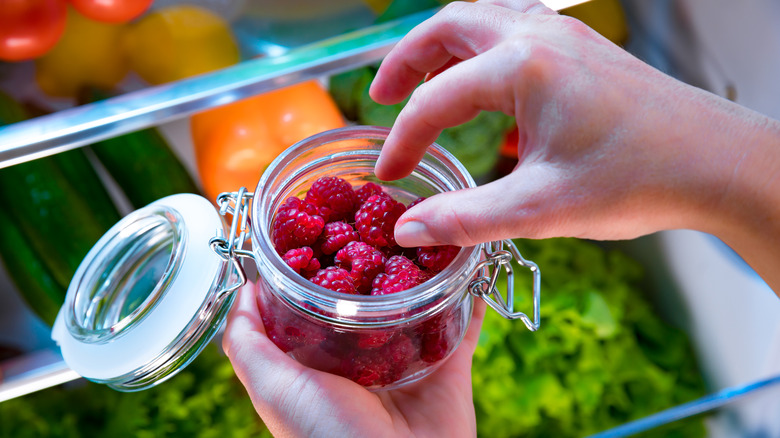13 Mistakes To Avoid When Picking Your Own Fruit
Not much can top biting into a crisp apple or a perfectly juicy and ripe strawberry. When you pick the fruit yourself, there is something even more enjoyable and delicious about each and every bite. Picking your own fruit can help you feel good about supporting a local farm and cutting down on the resources needed to transport items across the country. Going to a field to pick blueberries, peaches, raspberries, or the other fruits you love is also a fun adventure that gets you up and moving (sharing the time with friends or family can be an added bonus).
However, while picking your own can provide you with fresh fruit at the peak of freshness and keep you stocked up for healthy snacks and meals, there are several common mistakes that you'll want to watch out for. Making one of these mistakes could have a negative impact on the overall picking experience, leave you with underripe, overripe, or otherwise not tasty produce, cause the fruit you pick to spoil before you get a chance to use it, and more.
1. Heading to the field too late
One mistake you'll want to avoid when picking fruit is arriving at the field too late in the day. If you do, you may arrive only to find out that all of the fruit has been picked over and there isn't really anything left worth picking. New batches of strawberries, raspberries, and other fruits ripen each day. Getting to the field early in the morning — aim for close to the time it opens — will ensure you have a nice selection of ripe and delicious options at your fingertips.
Another reason to arrive early relates to your comfort. Many of the fruits you'll likely want to pick will be in season during the warmer summer months. If you're trying to pick later in the afternoon, the sun is going to be at a higher angle in the sky, beating down on you. Chances are you're going to feel overheated, which can definitely put a damper on your overall fruit-picking experience.
2. Not being prepared to pick
Before you leave home to go pick your own fruit, you need to make sure that you are prepared with everything you'll need. Unless the farm you're visiting explicitly states that it has containers for holding the fruit you pick, plan to bring your own buckets, bags, or canisters. If you're picking apples or other fruits that grow higher up in trees, you may also want to bring a fruit harvester pole with you.
Beyond having the appropriate tools for the job, being ready to go fruit picking also involves thinking about your comfort and safety. You'll (obviously) be outside, so it is a good idea to wear sunscreen and bring a hat to protect your face. Applying some bug spray can also be a good choice if you want to avoid getting bitten up as you pick. Put on a pair of comfortable, closed-toe shoes to protect your feet from branches or other obstacles that could be in the way. Finally, don't forget to bring a bottle of water and a few snacks for yourself and anyone else who is picking with you.
3. Picking fruit that is under- or overripe
Even if a particular field at the farm is open for picking, it doesn't mean that you should simply pick any berry, peach, or plum that you see. Some of the fruit may not be ripe and ready yet, while other pieces may be overripe.
Fruit that is picked too early often doesn't continue to ripen on the counter or in the refrigerator. It can be smaller, much firmer, and not nearly as tasty as fruit that has ripened on the vine or tree. On the other hand, you don't want to add overripe fruit to your picking pail, either. Overripe fruit will need to be eaten right away (if it hasn't already gone bad) and is much more likely to rot or bruise easily. Moreover, when overripe fruit is picked, its nutrient value decreases much more quickly than fruit that is picked at the appropriate time.
4. Not knowing how to pick the fruit
If you've never been to a pick-your-own farm before (or will be picking a new type of fruit for the first time), you need to know how to pick it. Picking techniques can vary for different types of fruit, and using the wrong method could cause you to inadvertently damage it. For example, if you're picking berries, you should simply slide your hand along the berries and catch any that drop off in your bucket. These will be the ones that are ripe and ready to enjoy, while any that remain on the bush will still need a little time to ripen.
When picking peaches, pomegranates, and many other fruits, you should twist the stem — not just pull it — to release them from the branches. You may also find that having a fruit-picker basket will simplify the task of picking fruit from trees. This tool features a long pole with a basket on the top to collect fruit from higher up in the tree. There is also a hook near the top of the basket that can be wrapped around the stem to help you release it from the tree.
5. Only picking perfectly-shaped fruit
Don't overlook a piece of fruit simply because it isn't "pretty." Just as we're all taught not to judge a person by how they look, but rather to focus on their inner beauty, the same is true when picking fruit. Misshapen fruit may look odd on the outside, but it should taste the same when you bite into it. The nutritional profile of these fruits will also be identical to their "pretty" counterparts. In some cases, you may even be able to buy imperfectly shaped produce for a discount.
Beyond the fact that oddly-shaped fruits taste just as good as the prettier choices, there is another reason to pick them: You're not the only one who is going to notice their unique shape. If everyone who picks fruit in the field passes by those that look strange, it will eventually over-ripen and rot. This can add to our country's already big problem with food waste.
6. Not having recipes planned to use the fruit you pick
Picking fruit can be fun. But, let's be honest, sometimes our eyes are bigger than our stomachs, or we aren't thinking clearly about how long the fruit will realistically stay good. Having some recipes planned out before you even go picking can help you avoid wasting fruit that doesn't get eaten.
The good news is that there are a plethora of delicious recipe options for nearly every type of fruit you can imagine. Going strawberry picking? Plan to make strawberry shortcakess, strawberry spinach salads, or strawberry pie. Heading to the apple orchard? Why not buy the other ingredients you'll need to make apple pie, apple cider, or apple butter? Peaches are another popular summer fruit. You can use them to make a peach cobbler, peach cake, or tomato and peach Caprese salad.
7. Not knowing the best way to freeze fresh fruit
Even with a full slate of recipes, you might still end up with more fruit than you can use up quickly. Knowing the best way to freeze fresh fruit will help you preserve the excess so that you can use it for later; you might even decide to pick a little extra on purpose so you can make smoothies and desserts throughout the year.
While the specific steps for freezing can vary based on the type of fruit, there are a few general guidelines to follow for the best results. First, you only want to freeze fruit that is ripe and at the peak of freshness. It will not continue to ripen in the fridge, so if you freeze it when it's underripe, it will still be hard and underripe when you thaw it. Another pointer for freezing fruit is to make sure that you put it in a freezer bag and remove as much air as possible. Always label the bags with the date to help ensure you use the fruit up while it will still offer the best taste.
8. Not canning or dehydrating the fruit to enjoy in the off-season
In addition to freezing, you can also can your fruit to preserve it for later use. Due to the fruit's high acidity levels, you do not need to use a pressure canner; either a steam or water bath canner will be sufficient for the task. Many types of fruit that you can pick are well-suited for canning, including berries, peaches (but not white peaches due to the lower acidity content), apricots, cherries, and apples.
Another way to preserve the fruit you pick for later enjoyment is to dehydrate it. Dried fruit can last several years when stored in an airtight container, and should last for at least a year in the pantry with basic storage techniques. Dehydrators are designed specifically for this task, but you can also dehydrate fruit in your oven, air fryer, or Instant Pot.
9. Getting fooled by imposters when picking strawberries
Believe it or not, there are mock strawberries out there. These imposters look very similar to the real thing — enough so that you might add them to your picking basket thinking you hit the strawberry jackpot. While you're not likely to run across these false strawberries when at a pick-your-own farm, you could be fooled by them if you're foraging berries in your yard or a forest.
Despite their similar appearance, mock strawberries do not taste the same as wild strawberries. While they are safe to eat, they have a very bland flavor that is nowhere near as enjoyable as the real deal. To avoid getting tricked into picking them, look at the direction it is growing. True wild strawberries grow downward, almost hiding amongst the leaves; their imposters, on the other hand, grow up from the leaves. The color of the flowers on the plants is another clue to pay attention to. While you'll see white or light pink flowers on a wild strawberry plant, mock plants will have little yellow flowers.
10. Not knowing the difference between edible and inedible wild berries
While many wild berries you find around your home or in the forests are nutritious and delicious, others are not safe to eat. Some are toxic and can lead to abdominal discomfort or even death (in rare cases when a large quantity is consumed).
Knowing which berries you can — and cannot eat — is essential if you plan to go foraging. You can safely pick and eat elderberries (only eat after cooking to inactivate the nausea-causing alkaloid compounds), huckleberries, gooseberries, buffaloberries, and mulberries. Mistletoe berries, holly berries, ivy berries, pokeweed berries, Virginia creeper berries, yew berries, Jerusalem cherries, and bittersweet berries are all poisonous and should be avoided. It's a good idea to take pictures of the berries you should avoid with you when foraging. And, of course, if you are not 100% certain about a berry, then it's best to simply avoid picking it.
11. Planning to pick fruit that is not in season
You can't simply wake up one day and decide you want to pick a particular type of fruit in the fields of a farm. You must check the website for the site you plan to visit to confirm the fruit is in season and available in its fields. Picking seasons vary from fruit to fruit, as well as the location.
In Florida, Texas, New Mexico, Southern California, and Arizona, citrus fruits are in season from November through March. Strawberry season runs from May to June, and cherries are available in June and July. Blueberries and blackberries will be ready to pick in June, July, and August, while peaches and raspberries are in season starting in July and running through September and October. Apple season starts in late August and runs through October. By knowing when the fruit is in season locally, you'll ensure you're heading out at the right times to get the best haul.
12. Not adhering to the farm rules and procedures
When you're picking fruit at a u-pick farm, it's important to remember that you're on someone else's property. Always be respectful and follow the rules and procedures. Take care not to waste fruit or toss it on the ground. Many farms do not allow eating on the field, so be honest and wait to eat until you've paid.
When walking through the fields, it is also important to show respect. Avoid stepping on any of the plants or fruit that may be on the ground. Instead of cutting between rows, walk to the end and turn to go down another row. If you bring any snacks, make sure the wrappers and any other trash are placed into a trash can or brought back home with you. Also, be advised that you most likely won't be able to bring your dog with you to go fruit picking as it may violate health codes.
13. Not properly storing the fruit once you get home
Knowing how to properly store the fruit you pick will help ensure it lasts for as long as possible. If you are planning to freeze, can, or dehydrate it, remember that it is best to use fresh, ripe fruit, so take care of these tasks as soon as possible. As for the rest of the fruit that you're planning to eat or cook, you'll need to know whether it should be stored in the refrigerator or left out on the counter.
All ripe fruit belongs in the refrigerator as it can overripen if left out. If it still needs to ripen, there are different rules for each type of fruit. Apples, oranges, pineapples, strawberries, cherries, blueberries, raspberries, grapefruit, oranges, and watermelon should be placed in the refrigerator right away. Peaches, nectarines, pears, plums, cantaloupes, apricots, and kiwis should be left out on the counter until ripe. You can also place them in a brown paper bag to help them ripen faster. Just be careful to check on their progress periodically so you can refrigerate them before they become overripe.
